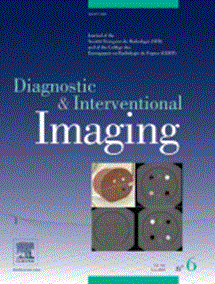光子计数ct在急性心肌炎中的细胞外体积:与心脏MRI的比较。
IF 8.1
2区 医学
Q1 RADIOLOGY, NUCLEAR MEDICINE & MEDICAL IMAGING
引用次数: 0
摘要
目的:通过与心脏MRI的比较,评价双源光子计数检测器计算机断层扫描(PCD-CT)心肌晚期碘增强用于疑似急性心肌炎患者细胞外体积(ECV)定量的可行性和准确性。材料与方法:本回顾性研究纳入临床怀疑为心肌炎而行冠状动脉CT血管造影(CCTA)排除冠状动脉病变的患者。所有患者均使用第一代PCD-CT进行CCTA检查,其中包括板岩碘增强图像。根据PCD-CT晚期碘增强图像上心肌与血池的碘比值计算ECV。根据Lake Louise 2018标准,采用综合心脏MRI方案作为确认心肌炎的参考方法。所有受试者均在24小时内使用PCD-CT和心脏MRI进行CCTA检查。计算PCD-CT晚期增强扫描的平均剂量长度乘积。使用Pearson相关检验评估ECV - PCD-CT(心内膜、心外膜、心内膜和全心)、心脏MRI-LGE和左右心室射血分数之间的相关性。利用Bland Altman图和线性回归分析比较PCD-CT和心脏MRI的ECV值。利用受试者工作特征曲线(auc)下的面积确定ECV-PCD-CT和ECV-MRI区分心肌炎患者与不符合Lake Louise标准的患者的最佳阈值。结果:纳入32例患者。男性19例,女性13例,平均年龄35.9±15.0(标准差[SD])岁;年龄范围:21-51岁)。PCD-CT晚期增强扫描的平均剂量长度积为96±32 (SD) mg .cm。PCD-CT计算的ECV平均值(29.4±4.5 [SD] %)与心脏MRI计算的ECV平均值(30.0±4.1 [SD] %)无显著差异(P = 0.69)。mri证实的心肌炎患者的ECV- ct值(31.65±3.6 [SD] %)高于正常患者(25.6±3.2 [SD] %) (P结论:在低辐射剂量下,利用晚期碘增强心脏PCD-CT图像获得的碘图计算ECV是可行和准确的。在胸痛的急性心肌炎诊断和预后评估中,PCD-CT似乎是一种很有前途的非侵入性成像方式。本文章由计算机程序翻译,如有差异,请以英文原文为准。
Photon-counting CT-derived extracellular volume in acute myocarditis: Comparison with cardiac MRI
Purpose
The purpose of this study was to evaluate the feasibility and the accuracy of myocardial late iodine enhancement for extracellular volume (ECV) quantification using dual-source photon-counting detector computed tomography (PCD-CT) in patients with suspected acute myocarditis by comparison with cardiac MRI.
Materials and methods
Patients with clinical suspicion of myocarditis who were referred for coronary CT angiography (CCTA) to exclude coronary artery disease were included in this retrospective study. All patients underwent CCTA examination using a first-generation PCD-CT, which included slate iodine enhancement images. ECV was calculated from the iodine ratio of the myocardium to the blood pool on late iodine enhancement PCD-CT images. A comprehensive cardiac MRI protocol was used as the reference method to confirm myocarditis according to the Lake Louise 2018 criteria. All subjects underwent CCTA using PCD-CT and cardiac MRI within 24 h. The mean dose-length product of late enhancement PCD-CT scanning was calculated. Correlations between ECV PCD-CT (endocardial, epicardial, midcardial, and global), cardiac MRI-LGE, and right and left ventricular ejection fractions were assessed using Pearson correlation test. ECV values derived from PCD-CT and those from cardiac MRI were compared using Bland Altman plots and linear regression analysis. Areas under the receiver operating characteristic curves (AUCs) were used to determine the optimal thresholds of ECV-PCD-CT and ECV-MRI for differentiating patients with myocarditis from those not meeting the Lake Louise criteria.
Results
Thirty-two patients were included. There were 19 men and 13 women with a mean age of 35.9 ± 15.0 (standard deviation [SD]) years; age range: 21–51). The mean dose-length product of late enhancement PCD-CT scanning was 96 ± 32 (SD) mGy.cm. No significant differences in mean global ECV were found between ECV calculated with the PCD-CT (29.4 ± 4.5 [SD] %) and that calculated with cardiac MRI (30.0 ± 4.1 [SD] %) (P = 0.69). ECV-CT was greater in patients with cardiac MRI-confirmed myocarditis (31.65 ± 3.6 [SD] %) by comparison with those with normal findings (25.6 ± 3.2 [SD] %) (P < 0.01). ECV-CT strongly correlated with LGE mass (r = 0.82) and showed strong segmental correlation with ECV-MRI (basal: r = 0.95; mid-ventricular: r = 0.91). An ECV-CT threshold of 26.9 % yielded an AUC of 0.95 (95 % CI: 0.84–1.00) for the diagnosis of myocarditis.
Conclusion
Calculation of ECV using iodine maps derived from late iodine enhancement cardiac PCD-CT images is both feasible and accurate at low radiation doses. PCD-CT appears as a promising non-invasive imaging modality for the diagnostic and prognostic assessment of acute myocarditis in the setting of chest pain.
求助全文
通过发布文献求助,成功后即可免费获取论文全文。
去求助
来源期刊

Diagnostic and Interventional Imaging
Medicine-Radiology, Nuclear Medicine and Imaging
CiteScore
8.50
自引率
29.10%
发文量
126
审稿时长
11 days
期刊介绍:
Diagnostic and Interventional Imaging accepts publications originating from any part of the world based only on their scientific merit. The Journal focuses on illustrated articles with great iconographic topics and aims at aiding sharpening clinical decision-making skills as well as following high research topics. All articles are published in English.
Diagnostic and Interventional Imaging publishes editorials, technical notes, letters, original and review articles on abdominal, breast, cancer, cardiac, emergency, forensic medicine, head and neck, musculoskeletal, gastrointestinal, genitourinary, interventional, obstetric, pediatric, thoracic and vascular imaging, neuroradiology, nuclear medicine, as well as contrast material, computer developments, health policies and practice, and medical physics relevant to imaging.
 求助内容:
求助内容: 应助结果提醒方式:
应助结果提醒方式:


